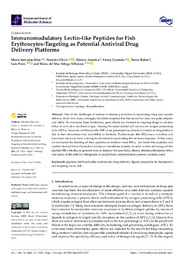Resumen :
Download PDFsettingsOrder Article Reprints
Open AccessCommunication
Immunomodulatory Lectin-like Peptides for Fish Erythrocytes-Targeting as Potential Antiviral Drug Delivery Platforms
by Maria Salvador-Mira 1,2,Veronica Chico 1,2ORCID,Monica Arostica 3,Fanny Guzmán 3ORCID,Nerea Roher 4,Luis Perez 1,2ORCID andMaria del Mar Ortega-Villaizan 1,2,*ORCID
1
Instituto de Biología Molecular y Celular (IBMC), Universidad Miguel Hernández (IBMC-UMH), 03202 Elche, Spain
2
Instituto de Investigación, Desarrollo e Innovación en Biotecnología Sanitaria de Elche (IDiBE), Universidad Miguel Hernández (IDiBE-UMH), 03202 Elche, Spain
3
Núcleo Biotecnológico de Curauma (NBC), Pontificia Universidad Católica de Valparaíso, Valparaíso 2373223, Chile
4
Department Biologia Cellular, Fisiologia Animal i Immunologia, Institut de Biotecnologia i de Biomedicina (IBB), Universitat Autònoma de Barcelona (UAB), 08193 Cerdanyola del Vallès, Spain
*
Author to whom correspondence should be addressed.
Int. J. Mol. Sci. 2021, 22(21), 11821; https://doi.org/10.3390/ijms222111821
Submission received: 1 October 2021 / Revised: 24 October 2021 / Accepted: 26 October 2021 / Published: 30 October 2021
(This article belongs to the Section Biochemistry)
Downloadkeyboard_arrow_down Browse Figures Versions Notes
Abstract
One of the challenges of science in disease prevention is optimizing drug and vaccine delivery. Until now, many strategies have been employed in this sector, but most are quite complex and labile. To overcome these limitations, great efforts are directed to coupling drugs to carriers, either of natural or synthetic origin. Among the most studied cell carriers are antigen-presenting cells (APCs), however, red blood cells (RBCs) are positioned as attractive carriers in drug delivery due to their abundance and availability in the body. Furthermore, fish RBCs have a nucleus and have been shown to have a strong involvement in modulating the immune response. In this study, we evaluated the binding of three peptides to rainbow trout RBCs, two lectin-like peptides and another derived from Plasmodium falciparum membrane protein, in order to take advantage of this peptide-RBCs binding to generate tools to improve the specificity, efficacy, immunostimulatory effect, and safety of the antiviral therapeutic or prophylactic administration systems currently used.
|
 La licencia se describe como: Atribución-NonComercial-NoDerivada 4.0 Internacional.
La licencia se describe como: Atribución-NonComercial-NoDerivada 4.0 Internacional.
.png)
